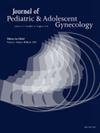55. Incidence, Indications, and Complications of Cesarean Delivery Among Adolescent Childbirths: National Inpatient Sample 2019-2021
IF 1.8
4区 医学
Q3 OBSTETRICS & GYNECOLOGY
引用次数: 0
Abstract
Background
Cesarean deliveries in the United States have increased over the recent decades. The impact of this increase on the adolescent population has not been precisely defined.
Methods
We performed a 3-year cross-sectional analysis of cesarean deliveries in individuals aged 10 to 19 years captured in the National Inpatient Sample from 2019 to 2021.
Results
Cesarean deliveries in individuals aged 10-19 represented 2.67 % of all cases. Geographically, over half of adolescent births occurred in rural areas (57.3 %), followed by urban areas (25.7 %), and least frequently in suburban regions (16.9 %). 38.9% of the individuals in the sample were identified as White, 29% as Hispanic, and 26.1 % as Black. Multifetal gestations accounted for 2.9 %. Among the most common diagnoses associated with cesarean, non-reassuring fetal status was documented in 41.4 % of cases, labor dystocia in 27 %, and repeat operation in 11.3 %. Notably, the incidence of failed TOLAC was 21.6 %. Incidence of commonly noted delivery complications was 10.7 % for meconium in amniotic fluid, 6 % for chorioamnionitis, 3.2 % for placental abruption, 2.9 % for multifetal gestation, and 2 % for malpresentation. Common maternal complications included anemia at 23 %, obesity at 15.4 %, mental health disorders at 11.1 %, gestational hypertension at 8.8 %, postpartum hemorrhage at 4.4 %, and blood transfusion at 3.5 %. Among severe complications, cases of placenta accreta spectrum, hysterectomy, and bowel or bladder injury were noted, though the incidence was very small (less than 0.1 % for all).
Conclusions
Cesarean delivery in adolescents is common, with indications similar to those previously reported in adult populations. Complications, including severe complications like placenta accreta disorders, organ injuries, and hysterectomy, did occur in this age group. Given the risk of complications and potential for future morbidity from repeat cesareans, monitoring rates of cesarean delivery in this age group and efforts for safe prevention of primary cesarean are warranted. These findings reaffirm the need to provide comprehensive obstetric and neonatal care to address complex health issues surrounding childbearing in this age group.
55. 青少年分娩中剖宫产的发生率、适应症和并发症:2019-2021年全国住院患者样本
背景:近几十年来,美国剖宫产的情况有所增加。这种增长对青少年人口的影响还没有得到精确的界定。方法:我们对2019年至2021年全国住院患者样本中10至19岁的剖宫产进行了为期3年的横断面分析。结果10 ~ 19岁剖宫产占2.67%。从地理上看,超过一半的青少年生育发生在农村地区(57.3%),其次是城市地区(25.7%),郊区地区的频率最低(16.9%)。样本中38.9%的人被确定为白人,29%为西班牙裔,26.1%为黑人。多胎妊娠占2.9%。在与剖宫产相关的最常见诊断中,有41.4%的病例记录了胎儿状态不稳定,27%的病例记录了难产,11.3%的病例记录了重复手术。值得注意的是,TOLAC失败率为21.6%。常见分娩并发症的发生率为羊水胎粪10.7%,绒毛膜羊膜炎6%,胎盘早剥3.2%,多胎妊娠2.9%,胎位不良2%。常见的产妇并发症包括贫血(23%)、肥胖(15.4%)、精神健康障碍(11.1%)、妊娠期高血压(8.8%)、产后出血(4.4%)和输血(3.5%)。在严重的并发症中,虽然发生率很小(小于0.1%),但仍注意到胎盘增生、子宫切除术和肠或膀胱损伤的病例。结论剖宫产在青少年中很常见,其适应症与先前报道的成人人群相似。并发症,包括严重的并发症,如胎盘增生障碍、器官损伤和子宫切除术,确实发生在这个年龄组。鉴于重复剖宫产的并发症风险和潜在的未来发病率,有必要监测该年龄组的剖宫产率,并努力安全预防初次剖宫产。这些发现再次表明,有必要提供全面的产科和新生儿护理,以解决与这一年龄组生育有关的复杂健康问题。
本文章由计算机程序翻译,如有差异,请以英文原文为准。
求助全文
约1分钟内获得全文
求助全文
来源期刊
CiteScore
3.90
自引率
11.10%
发文量
251
审稿时长
57 days
期刊介绍:
Journal of Pediatric and Adolescent Gynecology includes all aspects of clinical and basic science research in pediatric and adolescent gynecology. The Journal draws on expertise from a variety of disciplines including pediatrics, obstetrics and gynecology, reproduction and gynecology, reproductive and pediatric endocrinology, genetics, and molecular biology.
The Journal of Pediatric and Adolescent Gynecology features original studies, review articles, book and literature reviews, letters to the editor, and communications in brief. It is an essential resource for the libraries of OB/GYN specialists, as well as pediatricians and primary care physicians.

 求助内容:
求助内容: 应助结果提醒方式:
应助结果提醒方式:


